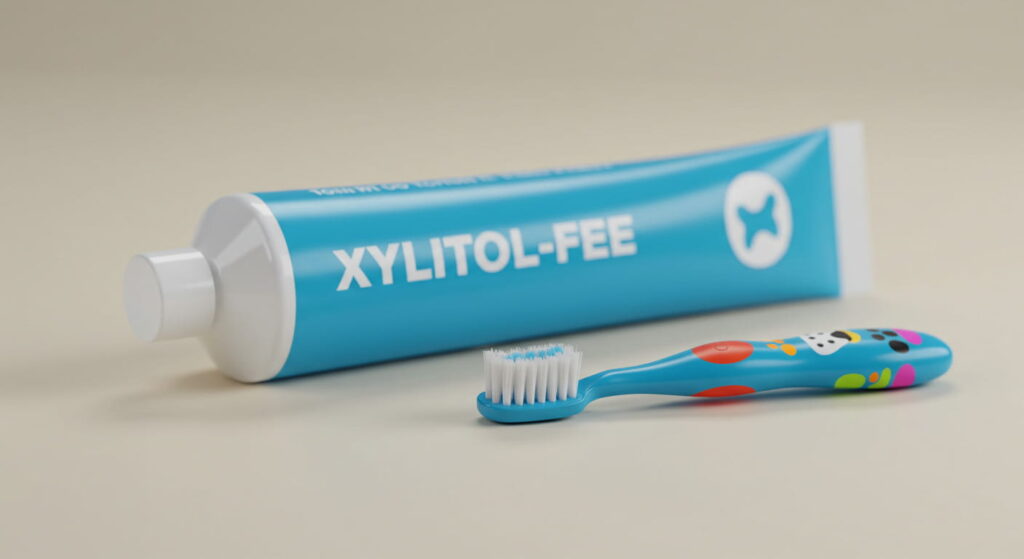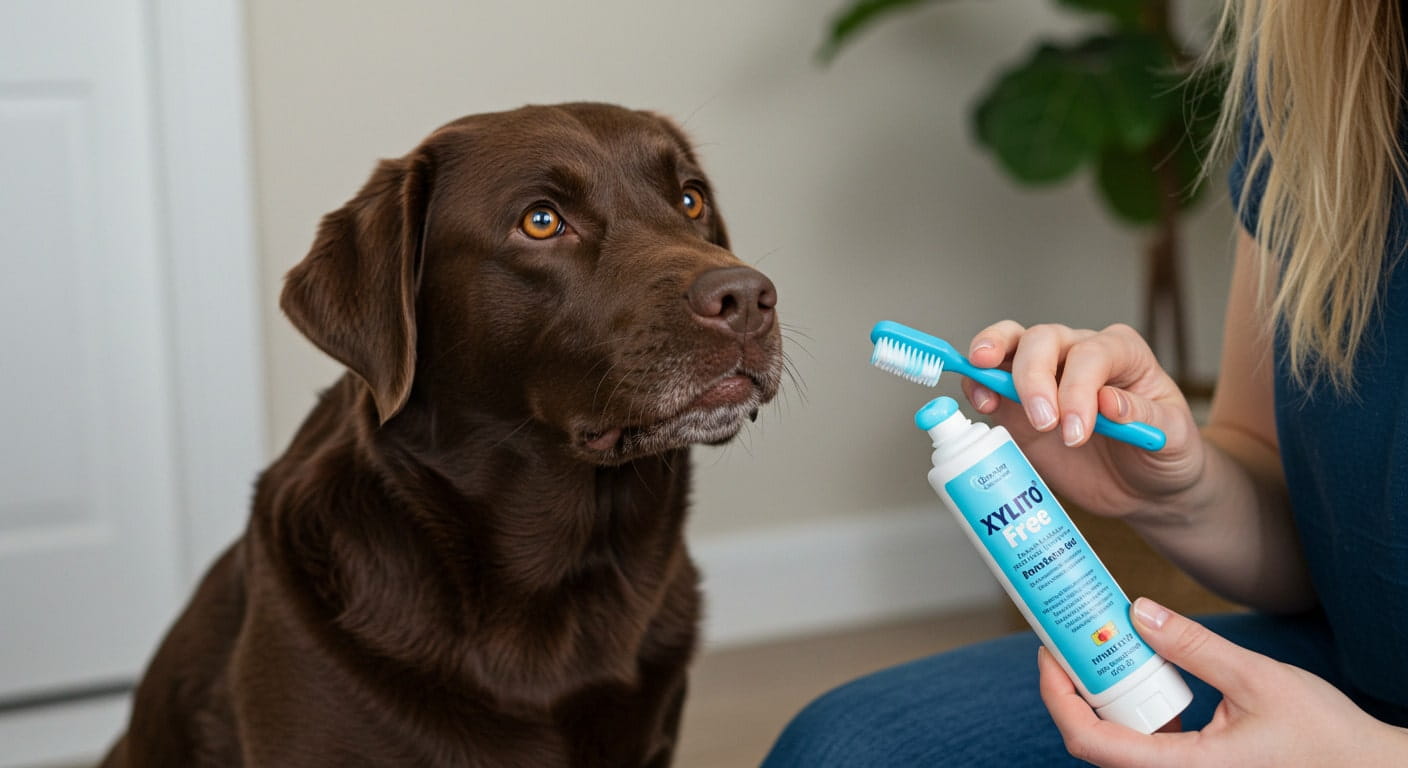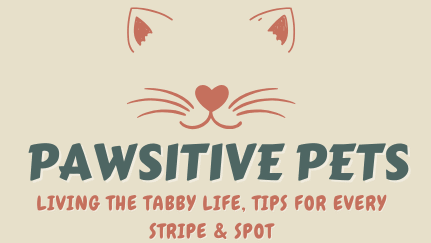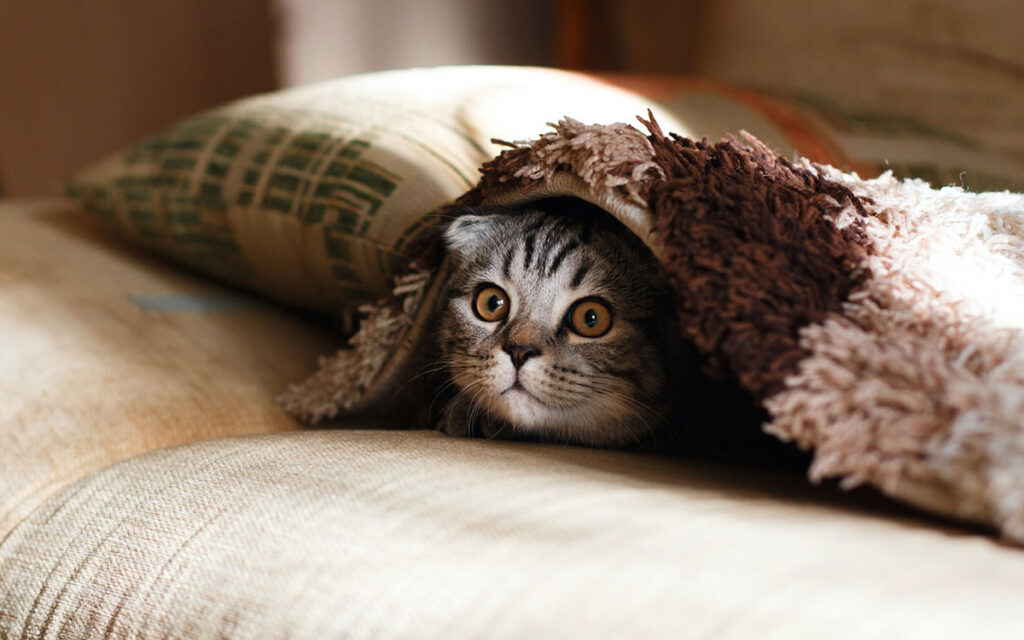How to brush your dog’s teeth may sound simple, but if you’ve ever tried it with a squirmy pup, you know it’s a challenge. I learned this firsthand with Max, my toothbrush-hating Labrador. After countless messy attempts, I finally figured out how to brush your dog’s teeth without stress, for either of us.
Most dogs show signs of dental disease by age three. That’s why learning to brush your dog’s teeth regularly is more than just a hygiene habit, it can add years to your dog’s life. A little patience, the right tools, and some tasty toothpaste can make all the difference.
Table of Content
Table of Contents
Why Dental Care Is Crucial for Your Dog’s Health
Understanding Canine Dental Anatomy
Dogs have 42 adult teeth compared to our 32, and each one plays a vital role in their daily life. From sharp canines made for tearing to flat molars for grinding, your dog’s mouth is a complex system that needs regular care. That’s why it’s crucial to learn how to brush your dog’s teeth and make it part of your routine. When you brush regularly, you help protect their dental anatomy and overall health.
Unlike humans, dogs can’t brush their own teeth, or let us know when something hurts. Their enamel is thin and doesn’t regenerate once damaged. That’s why learning how to brush your dog’s teeth is a preventative step every pet parent should take seriously to avoid painful dental problems.
The Consequences of Poor Dental Hygiene in Dogs
If you don’t know how to brush your dog’s teeth, plaque and tartar can quickly build up. This leads to more than just bad breath, it can trigger gingivitis and eventually periodontal disease. This serious condition affects the gums and bones supporting the teeth, often resulting in tooth loss, infections, and more.
In fact, studies show poor dental hygiene increases the risk of heart, liver, and kidney disease in dogs. Learning how to brush your dog’s teeth consistently isn’t just about oral health, it’s a step toward protecting your furry friend’s entire body.
Essential Tools and Products for Dog Teeth Brushing
Selecting the Right Tools: How to Brush Your Dog’s Teeth Starts Here

Not all dental products are created equal, especially when it comes to our furry companions. To master how to brush your dog’s teeth effectively, you’ll need the right supplies tailored for their unique needs.
Dog-specific toothbrush: These come in styles like finger brushes (fit over your fingertip), long-handled brushes (angled for canine mouths), and 360-degree brushes that clean multiple surfaces at once. Choosing the right brush is the first step in learning how to brush your dog’s teeth without stress.
Dog toothpaste: Never use human toothpaste, it often contains xylitol and other ingredients toxic to dogs. Instead, opt for enzymatic dog toothpaste in flavors like poultry or beef that your dog will love. It’s a game-changer when practicing how to brush your dog’s teeth consistently. For more safety tips, check out our guide to pet-safe household products.
When I first learned how to brush your dog’s teeth, I tried three different toothbrushes before Max found one he could tolerate. What works for one dog might not work for another, so don’t be afraid of a little trial and error.
Alternative Products That Support Dental Health
If traditional brushing is tough, don’t give up. These supplementary products can help you maintain oral hygiene while continuing to focus on how to brush your dog’s teeth long-term:
- Dental wipes: Quick and easy for removing plaque before it hardens
- Water additives: Mix into drinking water to reduce bacteria
- Dental chews and treats: Scrape plaque from teeth during chewing
- Dental toys: Textured toys that clean teeth during playtime
These products support dental health, but none of them replace learning how to brush your dog’s teeth properly. Think of them as helpful boosters, not full replacements.
Step-by-Step Guide to Brushing Your Dog’s Teeth
Preparing Your Dog for the Brushing Experience
ust like my shy tabby Luna needed time to adjust to her carrier, your pup also needs a gentle introduction when learning how to brush your dog’s teeth. Rushing the process can create negative associations that make future dental care more stressful.
Start teaching how to brush your dog’s teeth with these gradual steps:
- Let your dog taste and smell the toothpaste without brushing
- Gently touch and massage their muzzle and lips each day
- Lift the lip and softly touch their teeth and gums with your finger
- Introduce the toothbrush by letting them lick toothpaste from it
- Slowly increase the brushing time over several days
For many dogs, the toothpaste becomes a reward they love. Max, my Labrador, initially resisted, but once I learned how to brush your dog’s teeth patiently, he began sitting calmly the moment he saw the toothpaste tube.
Proper Brushing Technique and Duration
Once your dog feels at ease, it’s time to focus on how to brush your dog’s teeth using the right technique:
- Hold the toothbrush at a 45-degree angle to the gums
- Use gentle, circular motions on the outer tooth surfaces
- Focus on the back molars and canines where plaque builds up
- Spend about 30 seconds per quadrant (2 minutes total)
Always end the session with praise and a small treat to reinforce the positive experience.
Remember, consistency matters more than perfection. Even a quick session goes a long way when you’re learning how to brush your dog’s teeth regularly. You don’t have to get every angle perfect, just doing it often makes the biggest difference.
Dealing with Resistant Dogs During Teeth Brushing
Understanding Why Dogs Resist Dental Care

When Peanut and Butter, my guinea pigs, hide during nail trimming, it’s because they’re scared of the unfamiliar sensation. Dogs often react the same way to dental care, it’s strange, uncomfortable, and makes them feel restrained.
Common reasons your pup might resist include:
- Past negative experiences involving their mouth
- Gum sensitivity or existing pain
- Fear of new routines
- Instincts to protect their face
- Discomfort with being held still
My Lab Max used to refuse any form of dental handling. A previous owner had roughly forced his mouth open, and that experience left him anxious. Recognizing the emotional and physical causes of resistance helps you create a more positive, low-stress approach.
Training Techniques for Reluctant Pups
If your dog resists tooth brushing, don’t force it, focus on trust and gradual training. Positive reinforcement is your greatest ally. Behavioral strategies designed for anxious pets can be incredibly helpful here.
Try these gentle steps to ease your dog into a dental routine:
- Desensitization: Let your dog sniff the toothbrush regularly without using it
- Counter-conditioning: Reward even brief contact near the mouth with high-value treats
- Pick calm moments: After exercise or playtime when your dog is relaxed
- Try alternate tools: Some dogs do better with finger brushes than traditional ones
- Modify your position: Sitting beside your dog often feels less threatening than standing above them
I remember when Max would barely let me touch his face. We started with a single second of muzzle contact, followed by a treat. Over time, we built up to a full brushing session, no stress, no struggle, just trust.
Professional Dental Care Options for Dogs
When to Schedule Professional Dental Cleanings
Even with good at-home oral care, many dogs still benefit from professional cleanings. Vets generally recommend yearly dental check-ups, though some dogs may need cleanings more frequently depending on age, breed, or existing dental issues.
Signs your dog might need a professional cleaning:
- Persistent bad breath
- Tartar buildup (yellow or brown)
- Inflamed or bleeding gums
- Loose or missing teeth
- Changes in appetite or difficulty chewing
- Excessive drooling
- Pawing at the mouth
Senior dogs and breeds with small mouths, like Dachshunds, Greyhounds, and toy breeds, are especially prone to dental problems and often require more frequent vet visits.
What Happens During a Professional Dental Cleaning
Dental procedures for dogs involve more than just a quick polish. Because pets won’t sit still like humans, they’re placed under general anesthesia for safety and precision.
Here’s what to expect during a typical appointment:
- Pre-anesthetic bloodwork: Ensures your dog is fit for anesthesia
- IV catheter: For fluids and emergency access
- Anesthesia: Keeps your dog relaxed and pain-free
- Dental X-rays: Check roots and jaw health
- Scaling: Removes plaque and tartar above/below the gumline
- Polishing: Smooths surfaces to reduce future buildup
- Oral exam: Detects pockets, fractures, or other problems
- Treatment: Includes extractions if needed
- Monitoring: Your dog is watched closely during recovery
Most dogs go home the same day. While the procedure may cost $500–$1,000+, it prevents much more expensive and painful complications in the future.
Recognizing Common Dental Problems in Dogs
Identifying Tartar, Plaque, and Periodontal Disease
That brown stuff on your dog’s teeth? It’s likely tartar, mineralized plaque that has bonded to tooth enamel. Learning how to brush your dog’s teeth properly and regularly helps prevent these common dental issues:
- Plaque: A soft, clear or white film that forms within hours after eating
- Tartar (dental calculus): Hard, yellow to brown mineral deposits that brushing alone can’t remove
- Gingivitis: Red, swollen gums, often accompanied by bad breath
- Periodontal disease: Advanced inflammation causing bone loss and tooth mobility
Early detection is essential for effective treatment. Lift your dog’s lips each week and inspect for changes in color, gum condition, or odor. A strong routine that includes how to brush your dog’s teeth gives you a proactive edge in keeping their mouth healthy.
Warning Signs That Require Immediate Veterinary Attention
Some dental problems develop gradually, but others appear suddenly and require immediate veterinary care:
- Broken teeth, especially with visible pulp
- Oral bleeding beyond mild irritation
- Facial swelling, which may signal an infection or abscess
- Refusal to eat, particularly with signs of drooling or discomfort
- Severe halitosis, especially if it’s a sudden change
- Nasal discharge, sometimes tied to infected upper teeth
- Excessive drooling, especially if it’s tinged with blood or new
My neighbor’s dog stopped chewing toys and began pawing at his mouth. A vet visit revealed a fractured tooth needing extraction. That experience taught me to never ignore unusual behavior, especially when you’re just starting to learn how to brush your dog’s teeth and monitor their dental health.
Natural Supplements and Dietary Approaches for Canine Dental Health
Foods That Promote Healthy Teeth and Gums

Identifying Tartar, Plaque, and Periodontal Disease
That brown stuff on your dog’s teeth? It’s likely tartar, mineralized plaque that has bonded to tooth enamel. Learning how to brush your dog’s teeth properly and regularly helps prevent these common dental issues:
- Plaque: A soft, clear or white film that forms within hours after eating
- Tartar (dental calculus): Hard, yellow to brown mineral deposits that brushing alone can’t remove
- Gingivitis: Red, swollen gums, often accompanied by bad breath
- Periodontal disease: Advanced inflammation causing bone loss and tooth mobility
Early detection is essential for effective treatment. Lift your dog’s lips each week and inspect for changes in color, gum condition, or odor. A strong routine that includes how to brush your dog’s teeth gives you a proactive edge in keeping their mouth healthy. If you’re unsure how to brush your dog’s teeth, start small and build consistency—it’s more manageable than it seems.
Warning Signs That Require Immediate Veterinary Attention
Some dental problems develop gradually, but others appear suddenly and require immediate veterinary care:
- Broken teeth, especially with visible pulp
- Oral bleeding beyond mild irritation
- Facial swelling, which may signal an infection or abscess
- Refusal to eat, particularly with signs of drooling or discomfort
- Severe halitosis, especially if it’s a sudden change
- Nasal discharge, sometimes tied to infected upper teeth
- Excessive drooling, especially if it’s tinged with blood or new
My neighbor’s dog stopped chewing toys and began pawing at his mouth. A vet visit revealed a fractured tooth needing extraction. That experience taught me to never ignore unusual behavior—especially when you’re just starting to learn how to brush your dog’s teeth and monitor their dental health.
Maintaining a Consistent Dental Care Routine
Creating a Brushing Schedule That Works
Like the way Peanut and Butter expect their veggies at the same time each day, dogs thrive on routine. The ideal schedule for teeth brushing is daily, but consistent care several times a week is better than sporadic attempts.
Tips for establishing a sustainable routine:
- Link to existing habits: Brush your dog’s teeth after your own evening routine
- Start small: Begin with quick sessions (even 15 seconds) and gradually increase
- Use reminders: Set phone alerts or mark your calendar
- Be flexible: If you miss a day, simply resume the next day without guilt
- Track progress: Take periodic photos of your dog’s teeth to see improvements
I keep Max’s dental supplies in a basket by the couch so we can have our “tooth time” during evening TV watching. Finding what works for your lifestyle makes consistency much easier.
Looking for inspiration? best diet for aging pets to see what suits your furry friend best.
Celebrating Progress and Overcoming Setbacks
Dental care is a journey with ups and downs. Maybe your dog was doing great with brushing and suddenly becomes resistant, or perhaps you fell out of the habit during a busy period. These setbacks are normal and can be overcome.
Strategies for long-term success include:
- Reward system: Create a sticker chart or tracker and reward yourself and your dog for milestone achievements
- Mix it up: Rotate between different dental products to prevent boredom
- Involve family: Take turns with brushing duties to prevent caregiver fatigue
- Regular reassessment: Evaluate what’s working and what isn’t, and adjust accordingly
Remember when my normally cooperative Lab Max suddenly refused teeth brushing? It turned out he had a sore spot on his gum. After a vet check and brief pause in brushing, we were able to resume with a softer brush. Don’t be discouraged by temporary setbacks, they’re opportunities to learn.
FAQ: Common Questions About Dog Dental Care
What do vets recommend for brushing dogs’ teeth?
Veterinarians recommend daily brushing with dog-specific toothpaste and a soft-bristled toothbrush. Most vets emphasize that “consistency trumps perfection” brief, regular sessions are better than occasional thorough cleanings. They also recommend professional dental cleanings under anesthesia as needed, typically every 1-3 years.
How to effectively brush a dog’s teeth?
To effectively brush your dog’s teeth: Choose a calm time, apply dog toothpaste to the brush, hold it at a 45-degree angle to the gumline, and use small circular motions. Focus on the outer surfaces, especially the canines and back molars where tartar accumulates most. Keep sessions positive with praise throughout.
What is the brown stuff on my dog’s teeth?
The brown stuff is dental tartar (calculus), hardened plaque that forms when bacteria combine with minerals in saliva. Unlike plaque, tartar cannot be removed by brushing and requires professional dental scaling. Regular brushing prevents plaque from mineralizing into tartar.
What to do if a dog won’t let you brush their teeth?
If your dog resists: Start with handling exercises around their mouth, introduce tasty dog toothpaste as a positive experience, begin with a soft cloth before trying a brush, keep sessions extremely brief (5-10 seconds), and gradually build duration. Consider dental wipes or water additives while training.
Your Dog’s Smile Matters
Just as I’ve shared stories about Max, Luna, and the rest of my pet family throughout this guide, I hope you’ll create your own positive stories about dental care with your furry friend. Learning to brush your dog’s teeth properly isn’t just about fresh breath or pretty teeth, it’s about preventing pain and helping your dog live a longer, healthier life.
Starting a dental care routine might seem challenging, but the benefits far outweigh the initial hurdles. Whether you’re just beginning to brush your dog’s teeth or improving an existing routine, each brushing session is an investment in your dog’s wellbeing and another opportunity to strengthen your bond.
As we say in my home, “A healthy dog is a happy dog.” By incorporating regular dental care into your pet parenting approach, you’re taking a significant step toward ensuring your dog remains both healthy and happy for years to come.
Don’t be a stranger, share your dental care success stories or challenges in the comments below. Your experiences might just help another pet parent struggling with the same issues especially if you are a beginner . Remember, we’re all in this together, one toothbrush at a time!
Looking for inspiration? check How Much Should You Feed Your Cat Daily to see what suits your furry friend best.


